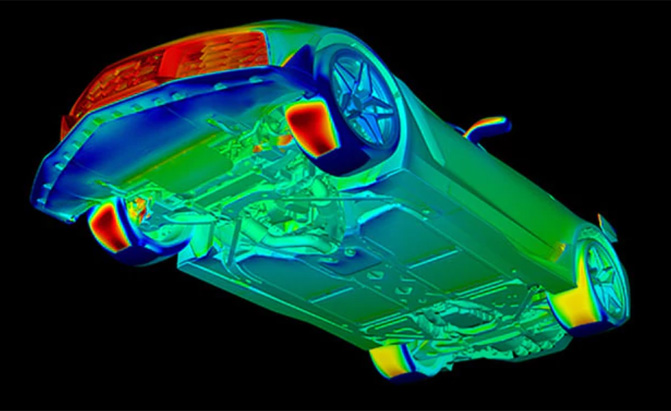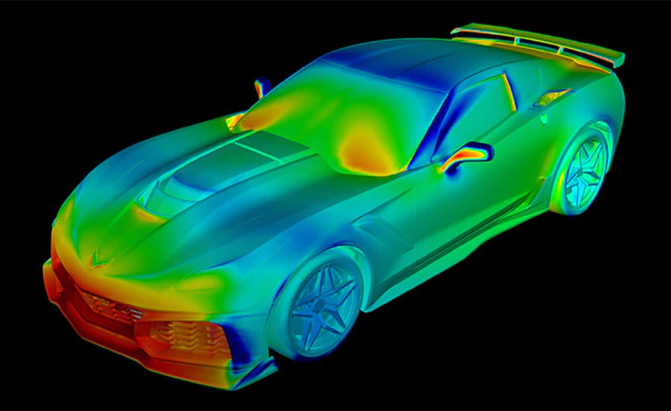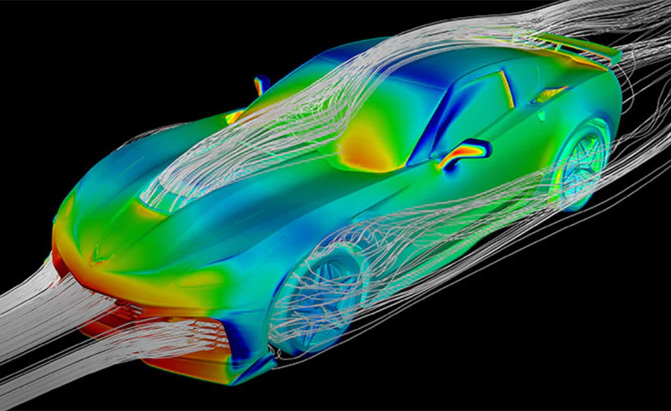Because everyone wants more ZR1.
Sure, the Chevrolet Corvette’s new supercharged LT5 V8 is a huge part of the car’s transformation into an allegedly fire-spitting supercar slayer, but its the ZR1’s revised front and rear aerodynamics that turn it into a real track basher.
It starts at the nose, where the ZR1 debuts a Corvette-first underwing which Chevy says trickled down from race car world. Air is funneled through a space between the front splitter and closeout panel which generate’s front downforce and helps pinch the air, creating a mild venturi effect which accelerates airflow under the nose (dark blue) and squishes the front tires into the road. You can see how the strakes (turquoise) help guide air through the underwing.
Airflow under the car becomes more turbulent aft of the nose as it swirls around the bottom of the engine and the rear transaxle. A rear diffuser wasn’t possible due to the placement of the Corvette’s stock mufflers. The C7.R GTLM avoids this problem by using side exit exhausts.
The key to the ZR1’s two-hundred-and-something top speed is the standard low rear wing. According to Chevy, the smaller pedestal wing creates 20 percent less drag than the optional adjustable high wing, but still generates more downforce than Z06’s wicker bill spoiler.
SEE ALSO: Attention World: the Corvette ZR1 is Back and it Has 750 HP
Serious track shoppers can opt for the available ZTK Performance Pack, which tacks huge endplates onto the front splitter and swaps the low wing for a high mounted version offering five degrees of adjustability. The end plates are creating additional downforce by extending the high-pressure zone (red) further across the front splitter, which also translates to increased pressure (green) climbing up the front fenders.
Whereas the standard setup only shows high-pressure downforce creation at the leading edge of the rear spoiler, the high wing shows high to mid-pressure (orange and yellow) downforce creation over a majority of its surface.
Lastly, there’s the effect of airflow on the car’s cooling. The ZR1 uses the power steering, differential, and transmission cooling module from the Z06, plus five additional heat exchangers– four of which sit hidden behind the car’s gaping air intakes. The side intakes channel air through the intercoolers and brake ducts before spitting it out fore of the front wheels, helping smooth airflow downstream. Air hitting the middle radiator is funneled through the engine bay and out through the LT5’s top-mounted heat exchanger before being picked up with the rest of the air traveling over the car’s roof.
You can also see how the Corvette’s rear quarter panel vents work, air is captured by the vents and forced (yellow) downwards towards the transmission and differential coolers.
Get the Flash Player to see this player.











